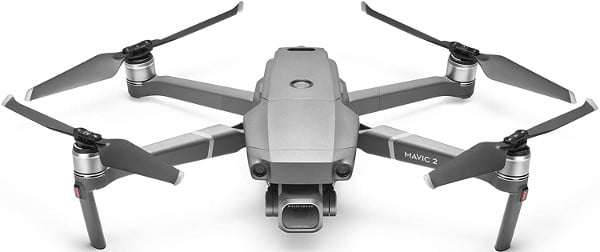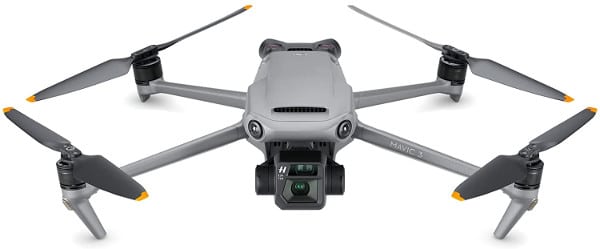The Mavic 2 Pro was one of DJI’s flagship drones until they stopped production late in 2021, it still is a great drone, especially for photography and comes with most of DJI’s innovative features. However, how does it compare against the recently released Mavic 3? The Mavic 3 is, without doubt, the superior drone, as you can see from the comparison table, but is it worth the huge price tag it comes with? That is something we hope to answer in this Mavic 2 Pro vs Mavic 3 article, personally, I would go for a completely different Mavic drone, which I shall mention near the end of this article.
One thing I want to remind anyone who is thinking of purchasing a prosumer drone like the Mavic Pro 2 or the Mavic 3, is to register the drone with your local government agency that oversees aviation rules and regulations.
In the USA that would be the FAA, and, in the UK, it is the CAA, if you are thinking of purchasing these drones for commercial purposes or will be likely to receive some form of compensation, you will need to obtain permission from these agencies in the form of passing a knowledge test.
In the USA, this test is known as the Part 107 certificate and will require you to sit a 2-hour exam in an FAA-approved testing centre.
In the UK, you only need to obtain an Operator ID & Flyer ID, to get the Flyer ID, you will need to pass a theory exam that is taken online.
However, if you deem that your drone operations will be close to people, you may also need to obtain a General Visual Line of Sight certificate. The certificate is issued by the CAA, but the actual exam is overseen by CAA approved recognised assessment entities (RAE’s).
For more information on what is required to operate a drone safely and legally please the CAA or FAA website.
Mavic 2 Pro vs Mavic 3 – Camera
When it comes to comparing prosumer drones, the main feature most people look at is the camera specs.
Both drones come with fantastic cameras which have been engineered jointly with legendary Swiss camera manufacturer, Hasselblad.
The superior camera is on the Mavic 3, it is the first DJI prosumer drone that comes with an MFT sensor, which is much larger than the 1-inch sensor on the Mavic 2 Pro.
According to the popular photography website, digital photography school, image sensor size is important in photography as bigger sensors will absorb more light which results in accurate image data being captured.
The benefits of a larger image sensor include better resolution thanks to more pixels spread out over a larger area, reduced noise in low-light environments and higher dynamic range.
The Mavic 3 camera has a 24mm ASPH lens, f/2.8-f/11 adjustable aperture, 84° FOV and can capture images in 20MP in 12-bit RAW format.
Features include 12.8 stops of dynamic range, vision detection autofocus technology and HNCS for accurate colour details in every image.
With its large sensor, adjustable aperture and smart photo mode, the Mavic 3 can capture amazing images in any type of lighting condition.
As for videos, the Mavic 3 takes video footage to another level, video footage can be recorded in 5.1k at 50fps, 4k/4k DCI at 120fps and 1080p at 200fps.
It supports video recording in H.264 & H.264 codecs and the Cine version supports recording in Apple ProRes 422 HQ.
For HDR videos, the camera records in 10-bit D-Log for a flatter colour profile that can be enhanced in post-processing.
One of the unique features of the Mavic 3 among prosumer drones is that there is a second camera on top of the main one.
This camera comes with a 12MP 1/2-inch sensor with a 162mm hybrid zoom lens and 15° FOV. It can zoom up to 28× and can be used to scout out areas of interest or to acquire close up shots with its digital + optical zoom feature.
The drone comes with 8GB of internal storage and has a memory card slot that can take up to a 1TB micro SD card.
As for the Mavic 2 Pro, while the camera is certainly not as impressive, it still is one of the best in its price range.
The camera has a 1-inch sensor with a 24mm lens, f/2.8-f/11 aperture and 77° FOV. It can capture 20MP images and has multiple photography modes and comes and it also comes with HNCS technology.
The drone can capture amazing night time images thanks to its hyperlight feature and 14 EV levels.
For videos, the camera can record in 4k at 30fps, 2.7k at 60fps and 1080p at 120fps and has a maximum video bitrate of 100Mbps.
For HDR videos, the camera can record in 10-bit D-log and 10-bit HDR, videos can be recorded in both H.264 & H.265 and there is an internal 8GB of storage as well as a memory card slot that can take up to 128GB.
Mavic 2 Pro vs Mavic 3 – Design
Both drones are well built and have a robust design, they can be operated in minus cold temperatures and have good resistance to winds of around 20mph.
The Mavic 3 is surprisingly lighter than the Mavic 2 Pro, despite being a larger drone, having a dual-camera system and more advanced features.
The Mavic 3 has a total of 8 sensors, they are situated on the front, back, lateral, top and bottom, these form part of the Mavic 3’s upgraded obstacle avoidance system which is on par with the Skydio 2.
There is also a LED light on the bottom to help you navigate better during night time operations.
The Mavic 2 Pro has a similar setup for its obstacle avoidance system, although it uses the less efficient APAS 1. O to the Mavic 3’s APAS 5.0.
The remote controllers for the two drones are completely different, the Mavic 3 has a similar controller to the Mavic Air 2S, while the Mavic 2 Pro controller is much similar to that of the original Mavic drone.
The Mavic 3 controller uses OcuSync 3.0 transmission technology, this allows the drone to stream videos from a maximum range of 15km.
The Mavic 2 controller uses the older OcuSync 2.0 for a maximum transmission range of 10km.
Another major difference between the two drones is the app that is used for FPV and to access the drones advanced features.
The Mavic 3 uses the newer DJI Fly app, while the Mavic 2 Pro is only compatible with the DJI GO 4 app.
The Mavic 3 Cine version of the drone comes with the DJI RC Pro controller, the defining feature of this controller is its large 5.5-inch screen which eliminates the need to attach your own smartphone. Other features include 32GB of internal memory, a micro SD card slot, allows you to run third-party apps and has 3 hours of operating time.
Flight Features & Performance
Both drones have 3 flight modes, positional mode, sports mode and tripod mode, the positional and tripod modes are similar to each other, except in tripod mode, the drones speed is limited to just 2.2 mph.
In sports mode, the obstacle avoidance is disabled as are the intelligent flight modes, the controls are more sensitive, and the drones can reach a top speed of 47 mph (Mavic 3) & 44 mph (Mavic 2 Pro).
The Mavic 3 comes with a triple GNSS receiver that can connect with 3 satellite systems, GPS, Galileo and BeiDou, while the Mavic 2 Pro has a dual GNSS receiver allowing to connect with GPS and GLONASS satellite systems.
Both drones can be operated in areas without a strong GPS signal thanks to their vision systems, this allows users to fly the drone indoors.
Intelligent flight modes like Active Track, Point of Interest and Spotlight are available on both drones, although the Mavic 3 comes with an updated version of these autonomous flight modes.
Some intelligent flight features such as Quickshots, tap fly and waypoint are available on the Mavic 2 Pro, but as of writing this article, they are not yet available on the Mavic 3.
The Mavic 3 does have the MasterShot feature that was introduced with the Mavic Air 2S, this is similar to the QuickShot feature but a little more complex manoeuvres are carried out by the drone.
Both drones come with hyperlpase feature, this allows users to create cool time-lapse videos complete hands-free via 4 different flight modes.
While both drones come with an automatic return to home feature, the Mavic 3 comes with an upgraded version of this flight mode. When the return to home feature is activated, the AI engine within the Mavic 3 works out the most efficient route to the home point and returns home safely.
The overall flight performance of both drones is very good as is expected from high-end DJI drones. Both these drones are easy to operate thanks to their advanced flight technology and features like intelligent flight modes and automatic return to homework as advertised.
Although the official flight time for both drones is 31 minutes and 46 minutes, this can only be achieved under perfect conditions, usually, you will get something a little less, so expect something in the range of 28 minutes for the Mavic Pro 2 and 42 minutes for the Mavic 3.
Final Thoughts
Without a doubt, the Mavic 3 is the superior drone, every feature has had an upgrade when compared to the Mavic 2 Pro and still, it’s lighter, which is an impressive engineering feat. However, these upgrades do come with a much bigger price tag and you will have to decide if it is worth the extra money.
The Mavic 2 Pro is still an excellent drone, especially for aerial photography and still remains one of the best overall drones in this category.
If you want a cheaper but still very good alternative to both drones, I highly recommend you check out the Mavic Air 2S, or you can click on the button below my top 10 list of the best drones for photography.



